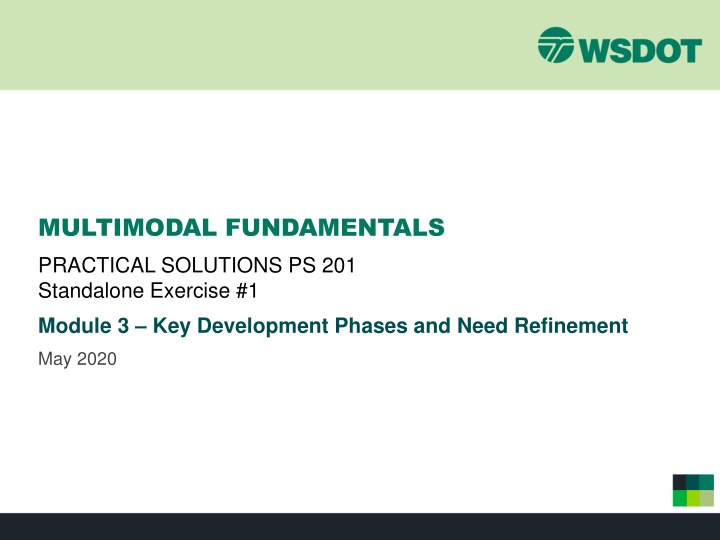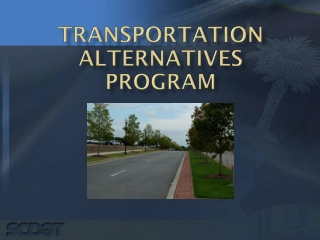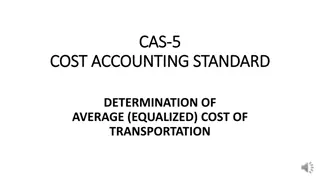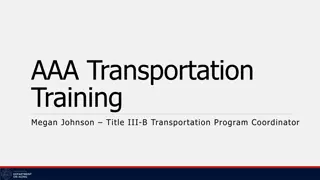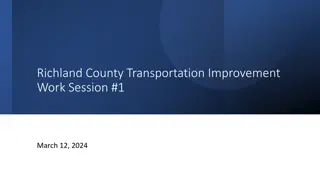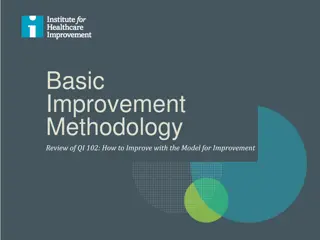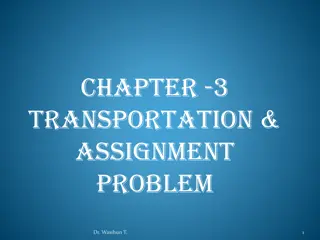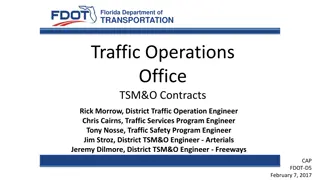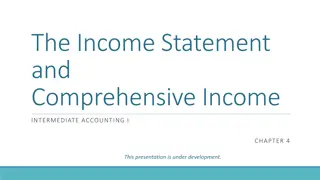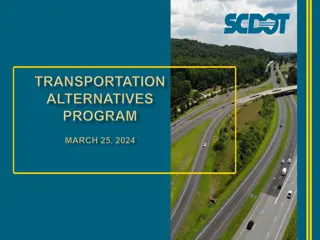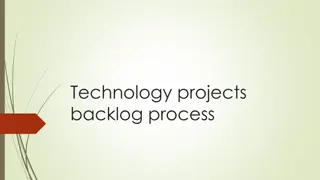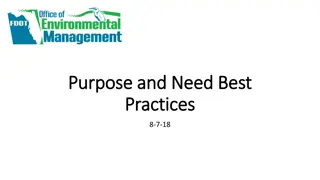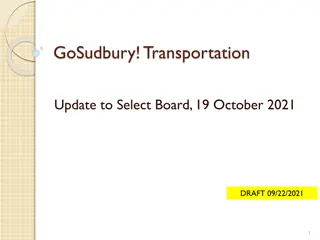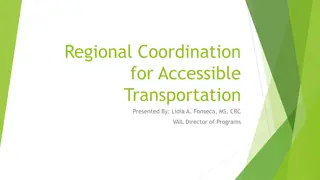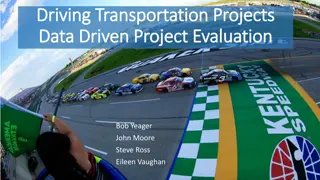Evaluating Purpose and Need Statements for Transportation Improvement Projects
This content discusses the evaluation and critique of purpose and need statements for transportation improvement projects focusing on roadway capacity and safety enhancements. It outlines the deficiencies in existing infrastructures, such as congestion, crash frequency, and future traffic projections, to justify the need for facility improvements. The aim is to enhance mobility, increase highway capacity, and improve safety along key segments of various routes. Each group analyzes assigned statements to identify gaps and potential limitations in modal alternatives, presenting their findings to the class for further discussion and analysis.
Uploaded on Sep 14, 2024 | 1 Views
Download Presentation

Please find below an Image/Link to download the presentation.
The content on the website is provided AS IS for your information and personal use only. It may not be sold, licensed, or shared on other websites without obtaining consent from the author.If you encounter any issues during the download, it is possible that the publisher has removed the file from their server.
You are allowed to download the files provided on this website for personal or commercial use, subject to the condition that they are used lawfully. All files are the property of their respective owners.
The content on the website is provided AS IS for your information and personal use only. It may not be sold, licensed, or shared on other websites without obtaining consent from the author.
E N D
Presentation Transcript
MULTIMODAL FUNDAMENTALS PRACTICAL SOLUTIONS PS 201 Standalone Exercise #1 Module 3 Key Development Phases and Need Refinement May 2020
GROUP EXERCISE GROUP EXERCISE Each group will be assigned one or two need statements to evaluate and discuss. The group is to critique the assigned statement(s) for completeness and information gaps, and whether the statement may inadvertently limit modal alternatives from being developed. Groups will provide a brief report out on their analysis of these statements to the full class.
PURPOSE AND NEED STATEMENT #1 PURPOSE AND NEED STATEMENT #1 The purpose of this project is to increase capacity on Route 787 from Killian Road to Blythewood Road and improve safety along the segment. The existing congestion and safety performance on Route 787 is considered deficient based on roadway capacity and an occurrence of traffic accidents. The following information justifies the need for the facility improvement: Roadway Capacity The existing facility consists of a two lane divided roadway with a 10ft raised median. Under existing conditions, the facility is operating at a LOS D with an ADT of 14,000. In the future (2035) the facility is projected to operate at an LOS F with an ADT of 24,000. Based on an increase in future traffic volumes the existing facility will not be able to meet future traffic demand. Safety Between 2007 and 2009 there were a total of 50 crashes along the project segment (average of 16.6). These crashes have resulted in 14 rear-ends, 20 property damage only, and 16 intersection related incidents. The expected number of crashes for this type of roadway is 10. The actual crash frequency is nearly 60 percent higher than the expected crash frequency.
PURPOSE AND NEED STATEMENT #2 PURPOSE AND NEED STATEMENT #2 The purpose of the SR888/123 Ave to Grant County Line Widening Project is to construct additional lanes for highway capacity. This section of SR888 has increasing congestion due to residential land development which has increased from 4 units/acre to 10 units/acre over the last decade. Multifamily housing developments are planned and expected to result in approximately 20 units/acre. The increase in resulting traffic volume over the last decade has resulted in more crashes on this segment of SR888. The need for the widening is to improve the existing two-lane highway to accommodate more capacity and improve safety.
PURPOSE AND NEED STATEMENT #3 PURPOSE AND NEED STATEMENT #3 The purpose of the proposed action is to enhance mobility from agricultural properties to US 777 and to improve safety on County Highway 50. The mobility and safety performance of County Highway 50 is considered deficient based on highway alignment, structural capacity, and location. The following deficiencies define the need for the facility improvement: 1) Highway Alignment - The current intersection with US 777 has limited intersection sight distance, which is below the distance recommended standards. An analysis of the crash history indicates a relationship exists between the documented crashes and the limited sight distance. 2) Structural Capacity - The bridge on County Highway 50 is subject to substructure scouring which severely limits the capacity of the bridge. 3) Location - A portion of County Highway 50, including the bridge, is within the flood plain of the Wells River. During high water, the access to agricultural properties are cut off since the road and bridge are submerged. High water causes erosion to the road and damages the bridge, and also provides difficult conditions for motorists traveling the road during these conditions.
PURPOSE AND NEED STATEMENT #4 PURPOSE AND NEED STATEMENT #4 The proposed intersection improvement will reduce collisions, delays and improve bicycle and pedestrian mobility and access to recreational activities and local resort businesses. The need for this improvement results from the hundreds of potential residential lots that may be accessed through this intersection. Even without the developed properties, the current average daily traffic has already risen to 10,000. These volumes are producing more frequent and longer delays for traffic on the minor road. Faced with these conditions, drivers are sometimes making decisions that result in a crash or a near miss. A new intersection is needed to accommodate higher traffic volumes while reducing the potential for serious collisions. Additionally this location needs: Better motorist information from new signs and striping Extended roadway life with new pavement
PURPOSE AND NEED STATEMENT #5 PURPOSE AND NEED STATEMENT #5 A section of State Route 999 in St. George has a history of pedestrian/vehicle crashes. In the last five years, there has been seven vehicle-pedestrian collisions on this segment of State Route 999. Three crashes resulted in fatalities, two crashes resulted in serious injuries and two resulted in minor injuries. The proposed action is to increase safe crossing opportunities for pedestrians on State Route 999 on this section. Based on crash locations, pedestrian crossing improvements are proposed at the following intersections: Brigham Drive at MP 0.35 Smith Avenue at MP 0.82 S. Harrison Avenue at MP 1.65 Wasatch Street at MP 2.51 Sandy Road at MP 2.73
PURPOSE AND NEED STATEMENT #6 PURPOSE AND NEED STATEMENT #6 The purpose is to relieve congestion and improve safety for both the traveling public and pedestrians. Drivers routinely experience congestion, delay and sudden stops for left turns on this two-lane highway. The need for the proposed action on this highway is based on several highway deficiencies, including shoulder width, turn lanes and lack of sidewalks based on similar roadways and current standards.
PURPOSE AND NEED STATEMENT #7 PURPOSE AND NEED STATEMENT #7 The purpose of constructing a Route 777 bypass around the Murray urban area is to provide a reliable high speed regional route between Weber and Davis counties. The bypass reduces congestion, improves safety through Murray, and provides an alternate route during recurring highway closures from crashes. A bypass around Murray is needed in order to improve regional mobility, increase capacity, reduce congestion through Murray, and improve safety. The need for a new roadway alignment in northeast Davis County to improve mobility and capacity was identified in the 1964 Route Development Plan, and in the 20-year State Highway System Plan. Davis County recently prepared a feasibility study to determine the best way of providing a better and safer flow of freight, goods, and people between Murray, West Jordan and Taylorsville. The study identified the need for a Murray bypass. A traffic analysis and transportation discipline study was completed in 2001, and concluded that route 777 will be unable to accommodate future traffic volume at an acceptable level of service (LOS). The proposed action will provide a solution to the immediate and long- range regional transportation mobility and safety needs of the Route 777 corridor in northeast Davis and southwest Weber Counties.
PURPOSE AND NEED STATEMENT #8 PURPOSE AND NEED STATEMENT #8 This stretch of Route 777 is the missing link between previously widened sections, leaving a three mile section between NE 15th Street and Route 888 where there is only one southbound lane and two northbound lanes. The purpose of this proposed action is to ensure route continuity and provide a continuous four-lane highway that stretches more than 8 miles across two counties and three cities. The need for Route 777 widening is based on traffic volumes that have exceeded the capacity of this highway during the afternoon peak commute, which doubles the travel time compared to off-peak travel. Higher traffic volumes increase the risk of serious cross over and head-on collisions as drivers try to turn across heavy traffic to access business and residential properties. High crash frequencies are contributing to congestion in this area.
PURPOSE AND NEED STATEMENT #9 PURPOSE AND NEED STATEMENT #9 Located in the City Industrial Area, the Freight Way/Boarder Road Intersection is a critical connection of SR 123 and SR 321, two Highways of Statewide Significance and part of the National Highway System, which support significant passenger and freight movement. The purpose of the Freight Way/Boarder Road Intersection Project is to develop an affordable long-term solution that: Maintains or improves emergency response Improves travel reliability for all vehicles Accommodates current and future freight truck and passenger vehicle movement through the intersection and across the region and states.
PURPOSE AND NEED STATEMENT #9 CONTD PURPOSE AND NEED STATEMENT #9 CONT D The Freight Way/Boarder Road Intersection generally accommodates the existing number of vehicles using the roadway; however, the intersection experiences heavy congestion during the PM peak hours with backups that are longer than available turn lanes for most turn movements. The westbound dual left turn backups are so long that vehicles frequently use the two-way left turn lane in the median that begins at Industrial Boulevard to bypass the queues that have formed in the westbound through lanes. Traffic volumes are expected to increase 60-70 percent by 2040, which results in failing conditions where vehicle drivers experience significant backups, waiting two or more signal cycles to pass through the intersection, and an intersection that is unable to accommodate the number of vehicles traveling to and from the Boarder Bridge. Much of the land south of Freight Way is zoned industrial and abuts Port River, which is compatible with manufacturing and export/import operations due to the river s deep-draft navigation channel.
PURPOSE AND NEED STATEMENT #9 CONTD PURPOSE AND NEED STATEMENT #9 CONT D Approximately 70 percent of these waterfront properties have active industrial operations whereas the remaining 30 percent are expected to develop within the next 5-20 years. With projected industrial growth and development of these waterfront properties, including lands west of the intersection, an increase in train operations on the railroads in the vicinity is similarly anticipated. Currently, an average of 4 trains cross at-grade per day. By 2040, 24-30 trains per day are anticipated to cross the intersection and will be unable to avoid the peak periods. Trains will routinely block the roadways for 5-11 minutes depending on train speed and length. This blockage and the time it takes to recover will substantially increase vehicle travel times compared to travel times when no trains are present. The frequency of this train activity increases the probability that freight truck and passenger vehicles will be blocked or encounter congestion. All travel through this intersection and throughout the industrial corridor and nearby roadways will be less reliable, including commuting to and from work, making freight deliveries, and providing school bus and transit service.
PURPOSE AND NEED STATEMENT #9 CONTD PURPOSE AND NEED STATEMENT #9 CONT D Emergency service providers routinely travel through the Freight Way/Boarder Road Way intersection. The City Fire Department (located 1 mile north of the intersection) travels Boarder Road to respond to fire and emergency calls in the industrial areas southwest and southeast of the intersection; ambulance service returns through the intersection to transport patients to the St. Francis Medical Center located approximately 1 mile north of the intersection. Increased congestion at the Freight Way/Boarder Road intersection will impede and delay critical response and transport times for emergency service providers.
